|

Tuesday, 20 November 2007
from
BBC Website
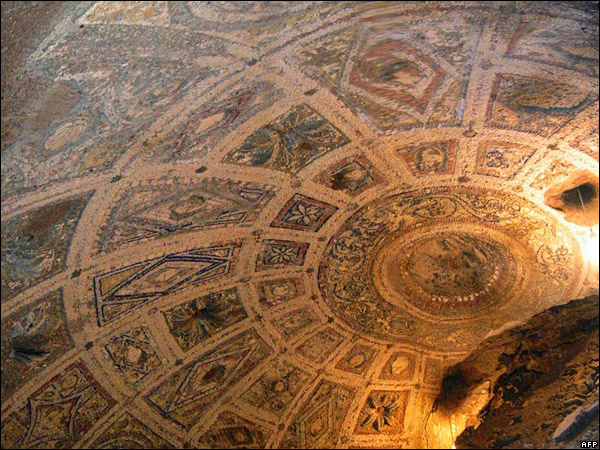
Probes revealed a
ceiling with a white eagle at the centre.
A camera probe sent
into the cave revealed a ceiling covered in shells,
mosaics and coloured
marble and with a white eagle at the centre.
Italian archaeologists say they have
found the long-lost underground grotto where ancient Romans believed
a female wolf suckled the city's twin founders.
The cave believed to be the Lupercal was found near the ruins of
Emperor Augustus' palace on the Palatine hill.
The 8m (26ft) high cave decorated with shells, mosaics and marble
was found during restoration work on the palace. According to
mythology Romulus and Remus were nursed by a she-wolf after being
left on the River Tiber's banks. The twin sons of the god Mars and
priestess Rhea Silvia are said to have later founded Rome on the
Palatine in 753 BC.
"This could reasonably be the place
bearing witness to the myth of Rome - the legendary cave where
the she-wolf suckled Romulus and Remus".
Francesco Rutelli
Italian Culture Minister
The brothers ended up fighting over who
should be in charge of the city, a power struggle which ended only
after Romulus killed his brother. In Roman times a popular festival
called the Lupercalia was held annually on 15 February.
Young nobles called Luperci, taking their name from the place of the
wolf (lupa), ran from the Lupercal around the bounds of the Palatine
in what is believed to have been a purification ritual.
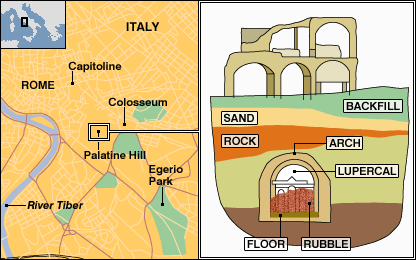
Cross-section of the
Palatine hill showing cave
Naked, except for the skins of goats that had been sacrificed that
day, they would strike women they met on the hands with strips of
sacrificial goatskin to promote fertility.
'Astonishing
history'
Presenting the discovery, Italian Culture Minister Francesco Rutelli
said archaeologists were "reasonably certain" that the newly
unearthed cave could be the Lupercal.
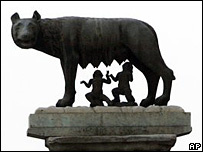
According to myth,
Romulus and Remus were nursed by a she-wolf
"This could reasonably be the place
bearing witness to the myth of Rome, one of the most well-known
cities in the world - the legendary cave where the she-wolf
suckled Romulus and Remus, saving them from death," he said.
"Italy and Rome never cease to astonish the world with continual
archaeological and artistic discoveries, and it is incredible to
think that we have finally found a mythical site which, by our
doing so, has become a real place."
The ancient cave was found 16m (52ft)
underground in a previously unexplored area during restoration work
on the palace of Augustus, the first Roman emperor.
Exploration of the cavity was hampered, however, by fears that it
might collapse and damage the foundations of the surrounding ruins.
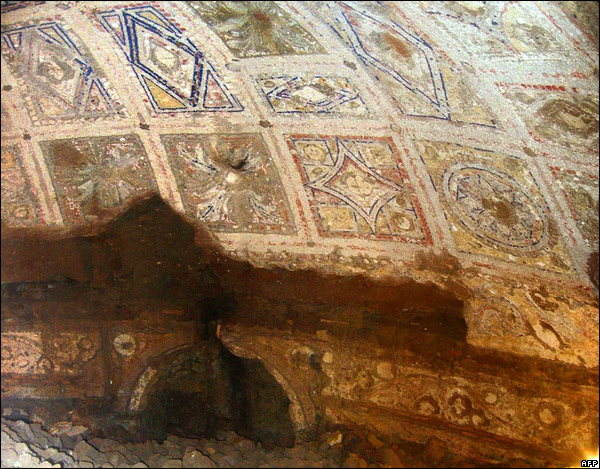
Exploration of the
cave was hampered by fears that it might collapse
and damage the
foundations of the monuments on the Palatine hill.
Archaeologists therefore used endoscopes
and laser scanners to study it, ascertaining that the circular
structure was 8m (26ft) high and 7.5m (24ft) in diameter.
A camera probe later sent into the cave revealed a ceiling covered
in shells, mosaics and colored marble, with a white eagle at the
centre.
"You can imagine our amazement - we
almost screamed," said Professor Giorgio Croci, the head
of the archaeological team working on the restoration of the
Palatine, told reporters.
"It is clear that Augustus... wanted his residence to be built
in a place which was sacred for the city of Rome," he added.
The Palatine hill is covered in palaces
and other ancient monuments, from the 8th Century BC remains of
Rome's first buildings to a mediaeval fortress and Renaissance
villas. After being closed for decades due to risk of collapse,
parts of the hill will re-open to the public in February after a
12m-euro ($17.7m) restoration program.
That didn't stop the site from becoming a sacred place to ancient
Romans.
Every year on February 15 ancient priests killed a dog and two goats
and smeared the foreheads of two boys from noble families with the
sacrificial blood as part of the Lupercalia celebration. (Related:
"'Rome'
TV Wardrobe Not Built in a Day"
- August 26, 2005)
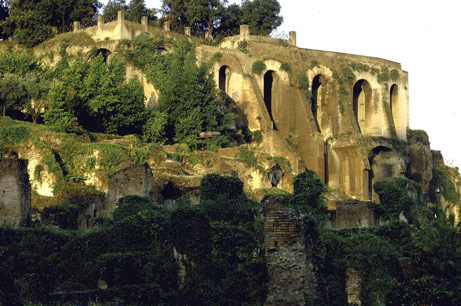
Rome's Palatine Hill,
once the home of the city's wealthiest and most influential
residents,
is now a warren of
crumbling imperial palaces.
While working to restore the palace of Emperor Augustus,
archaeologists
recently came across a chamber they say is Lupercale—the sacred cave
where a she-wolf is
said to have suckled Romulus and Remus, the city's legendary
founders.
The ceremony survived until A.D. 494,
when Pope Gelasius put an end to the tradition. The Palatine Hill
also became the residential area of the most affluent Roman citizens
beginning in 500 B.C. When the Roman Republic became the Roman
Empire in the first century B.C., Augustus even built himself and
his wife Livia palaces on top of the hill.
Later emperors followed his example and built larger and larger
homes on the same spot. Now the whole hill is a honeycomb of
buildings and tunnels extending far underground.
The English word "palace" derives from "Palatium," the Latin name of
the area.
Crumbling
Ruins
"The tale of the birth of Rome is
part myth and part historical truth," said Andrea Carandini,
historian and archaeologist at the University of Rome, La
Sapienza.
"The story of the twins reflects the previous tradition of the
Lares, the twin deities protecting the area, but there was
indeed a historical founder who constituted the Palatine Hill as
the sacred heart of the city around 775 B.C.," he added.
"The archaeological findings are providing more and more
evidence that the tale of Rome's foundation isn't a later legend
but originates from historical facts," he said.
Time may been running out for additional
discoveries, however.
"The remains are now crumbling due
to atmospheric agents and lack of funds for maintenance," head
archaeologist Iacopi said. "Most of the buildings are
closed to the public for safety reasons. It's a real pity."
"Archaeologists are doing what they can to restore and stabilize
the ruins," she added.
"Now we have to find the entrance and study the chamber," Iacopi
said.
"In the meantime we are going to finish the restorations in
Augustus' palace. We hope to open part of the emperor's
residence to the public in a few months."
Multimedia
|





